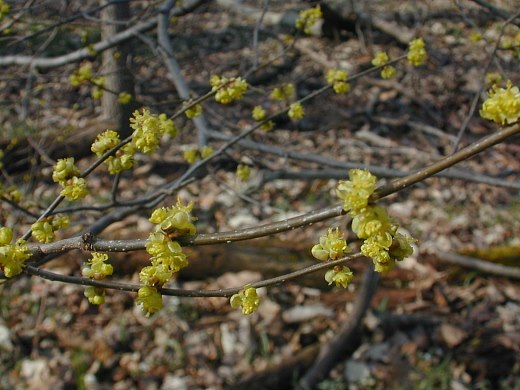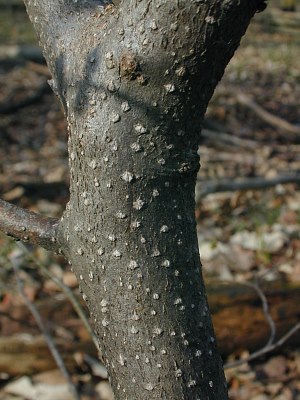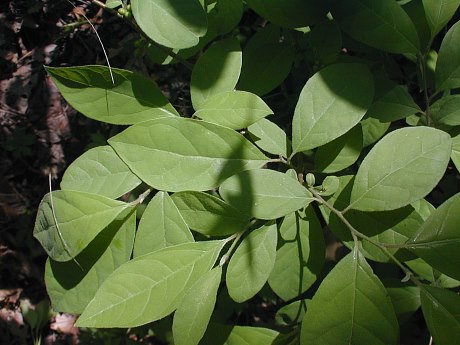Description: This woody shrub is about 5-15' tall and much branched. The central trunk (if present) and larger branches are rather slender; their bark is brown, shiny, and sparsely covered with small white lenticels. These lenticels are circular-angular in shape. The slender branchlets are shiny and brown; their lenticels are white, dot-like, and insignificant.

Alternate leaves are produced along new branchlets. The larger leaves are up to 5" long and 2½" across; they are ovate or ovate-obovate, smooth along their margins, wedge-shaped at their bottoms, and hairless. The slender pedicels of the larger leaves are up to ½" long. The smaller leaves are less than 2" long, more rounded and oval in shape, and less conspicuous than the larger leaves; otherwise, they have similar characteristics. Both types of leaves are medium green on the upper surface, and pale green on the lower surface. There is a variety of Spicebush that has pubescent branchlets and leaves, but it is uncommon and restricted to southern Illinois. The yellow flowers are perfect or dioecious (male & female flowers on separate shrubs); they occur in small clusters along the branchlets before the leaves develop. Individual flowers are less than ¼" across; each flower has 6 yellow sepals with a petal-like appearance and no petals. The male flowers have 9 stamens (organized into 3 groups), while the female flowers have an ovary with a single style and up to 18 pseudo-stamens. The blooming period occurs during the mid-spring and lasts about 2 weeks. The flowers are fragrant; the crushed leaves and branchlets have a spicy aroma. Each fertile flower is replaced by a fleshy ovoid drupe with a single stone; this drupe becomes red when it is mature during the late summer or fall. The woody roots are shallow and much branched. This shrub reproduces by reseeding itself.
Cultivation: This shrub prefers dappled sunlight to medium shade, moist to mesic conditions, and a fertile loamy soil with decaying organic matter. It is adaptable to cultivation in yards and gardens.

Range & Habitat: The native Spicebush is common in the southern half of Illinois, occasional in NE Illinois, and largely absent in the NW section of the state (see Distribution Map). Habitats include rich deciduous woodlands, wooded bluffs, bottomland forests along rivers, wooded slopes (usually toward the bottom), and gravelly seeps in shaded areas. While Spicebush is fairly shade-tolerant, it benefits from occasional disturbance that reduces the dense shade of some canopy trees, particularly Sugar Maple, American Beech, and similar trees.
Faunal Associations: The flowers are cross-pollinated by various insects, particularly small bees and various flies (Gagliardi & Walker, 2018). Krombein et al. (1979) reported Andrenine bees (Andrena imitatrix imitatrix, Andrean nuda) as flower visitors. Insects that feed destructively on Spicebush include the larvae of the Sassafras Borer (Oberea ruficollis), larvae of the Spicebush Stem Gall Midge (Neolasioptera linderae), larvae of the moths Tulip Tree Beauty (Epimecis hortaria) and Promethea Moth (Callosamia promethea), and larvae of a butterfly, the Spicebush Swallowtail (Papilio troilus); see Yanega (1996), Felt (1917), and Wagner (2005). Among vertebrate animals, many species of birds consume the red fruits occasionally, spreading the seeds of this shrub to new locations (see Bird Table). This includes such birds as the White-throated Sparrow, Veery, Grey-cheeked Thrush, Wood Thrush, Eastern Kingbird, and Red-eyed Vireo. In Kentucky, Elk have been observed to browse on the leaves and twigs (Schneider et al., 2006).
Photographic Locations: Busey Woods in Urbana, Illinois, and a wooded bluff in Vermilion County, Illinois.

Comments: This attractive shrub is quite conspicuous during the spring when the flowers bloom; it is one of the first shrubs to bloom in wooded areas. During the summer, it fades into the background and becomes rather ordinary-looking; however, it can be readily identified by the spicy aroma of its crushed leaves and branchlets. During the fall, Spicebush becomes attractive once again when its leaves turn yellow and its fruit becomes red. Another woody species with a similar distribution in Illinois, Sassafras albidum (Sassafras), is a small to medium tree with similar flowers and aromatic foliage. Unlike Spicebush, some of its leaves have lobes (2-3) and its mature fruits are blue.